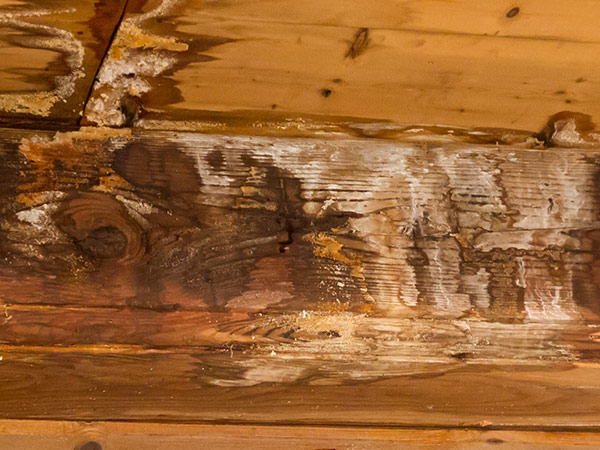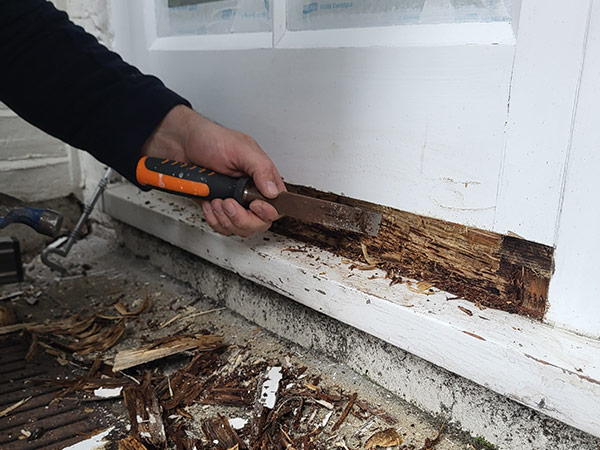

Is It Wood Rot? A Question You Need to Answer Fast
Rain, floods, or just a sneaky drip can cause wood to rot. In a building, wood rot is frequently a silent enemy that suddenly makes itself known when a porch step sags or a door won’t shut. But there are ways to spot wood rot – and make repairs – before it gets too far along. Here’s everything you need to know about identifying and repairing wood rot.
What is Wood Rot and What Causes It?
Wood rot occurs when wood in a structure is exposed to water, either for an extended period or in conditions that prevent it from fully drying. Wet conditions can introduce wood-eating fungi. These fungi have just one goal: to break down wood.
A basic rule of thumb is any wood that has more than 20% moisture content, and either isn't able to dry out completely or is repeatedly re-introduced to water, will begin to decay. This could happen during a flood or over time from rain or a slow plumbing leak.
The main types of wood rot fall into two broad categories of “wet rot” or “dry rot.” But there are several other notable subtypes of wood rot you could see.


Types of Wood Rot
- Basic wet wood rot: Wet rot is caused by the fungus Coniophora Puteana which feeds not only on wet wood, but can also break down plaster, wallpaper, and even carpet. You may see wood with black mold that is soft or spongy, or that has cracked paint lifting away from the wood.
- White (wet) wood rot: A quick clue that you have “white rot” is the color the fungus is producing. When this fungus digests wood it breaks down the chemistry of the wood producing a white or yellowish color. Any white rot will cause the wood to lighten because it’s eating the elements that give wood a dark color. It will also become fibrous in texture.
- Dry wood rot: Dry rot is caused by the fungus Serpula Lacrymans which also breaks down wood, but the timber in question may “look” dry. It still requires high moisture levels to take hold, so the name “dry rot” is a bit of a misnomer. If you are dealing with dry rot, you should see the wood is shrunken, darker than normal, and broken into cube-like shapes or a “cubical fracture.” Dry rot is also very difficult to contain because the fungus can travel from wood touching brick or plaster and pass into wood on the other side.
- Soft wood rot: Mostly seen in fallen timber, not in lumber used in homes, soft rot can infiltrate a structure if it is exposed to harsh conditions. Soft wood rot can grow in temperatures as low as 0°F (instead of warm conditions typical for most other wood rot).
What Are the Signs of Wood Rot and Where Do I Need to Look?
Wood rot can be visual such as when the wood is discolored (lighter or darker) or it is warped or cracking. It can also be audible, however. Knock on wood affected by wood rot and it will sound “hollow” – that’s because the fungus has eaten away part of the wood itself, leaving a dry, crumbly mess behind. But the most universal test is to simply poke it – or a “pick test.”
Try inspecting for wood rot yourself with a simple tool like a screwdriver, poking into wood in areas you suspect could be damaged. If your tool sinks easily into the wood – that’s a good sign there’s rot. You might also look for the visual changes, as well as new “growth” of fungus, and even mushrooms!
Spotting Wood Rot Can Be Easy. Look for Wood Rot in Any of the Following Areas:
- Roofs, gutters, and soffits
- Attics
- Sinks and any "wet room" with plumbing
- Windowsills and windowframes
- Door frames
- In and below showers/tubs
- Basements and crawl spaces
- Decks
- Siding or paneling, especially wood siding
- Steps, porches, or stoops
- Areas of condensation

Is There a Wood Rot Treatment? Is My Wood a Goner or Can I Fix It?
The great news is that you can repair (and not always replace) wood damaged by wood rot. It all depends on what type and how advanced the wood rot is.
- Getting rid of dry rot: Dry rot can be repaired and even stopped by a thorough drying out and removal of the affected rotten wood. But you should always inspect cases of dry rot thoroughly and may even consider getting the opinion of a professional (or two) to ensure mitigation is completely effective.
- Treating wet rot damage: Start by treating the wet rotten wood with an appropriate fungicide and letting the treatment fully dry. You can hire a pest professional for this application, but also be wary of scams after disasters like floods.

If you want to repair a very small, affected area, like a small area of a door jamb or frame, you can use various types of repair techniques.
- Repairing wet rot damage: To repair wet rot (instead of fully removing entire boards) after fungicidal treatment, see if the wood is very soft or only slightly damaged. Things to consider:
- If it's slightly damaged (less than 15% of the wood is affected) and not a structural issue.
- Replace only if it's not an overly complex issue.
- Helpful materials for a small repair like this include a wood hardener to solidify any slightly soft wood, wood putty, and wood filler.
- Replacing wet rot damage: Sometimes a simpler solution is to remove any materials (drywall, plaster, etc.) that could be preventing full drying out (or harboring mold). Then remove any rotten wood entirely. Scrape it out with a sharp tool and it should crumble away.
Finally, fix any areas that allowed water to cause damage, like leaking pipes or damaged shingles on the roof. Monitor these repairs during and after storms or other conditions that led to the previous water damage and make sure the repairs were done correctly.
Get Help for Wood Rot at McCoy's
Finding wood rot can be stressful but finding help at McCoy’s doesn’t have to be. Our experts can talk with you about what type of rot you’re dealing with and help you find resources for treatment, repair, or replacing rotten wood. Plus, all the materials you need to stop water in its tracks like fixing that leaky toilet. After a flood or emergency event, McCoy’s can also help you with ventilation, drying out, and moving forward – leaving wood rot behind.
